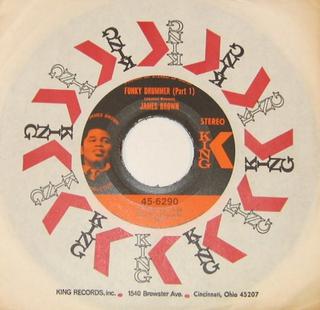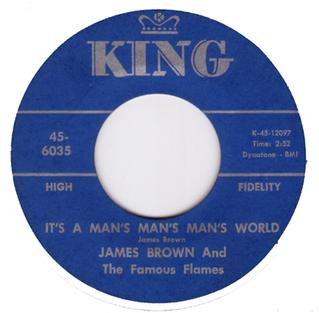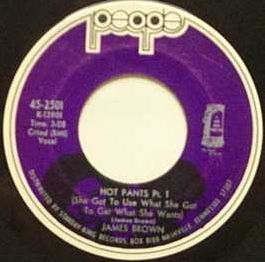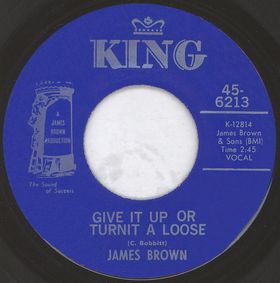
"Funky Drummer" is a single released by James Brown in 1970. Its drum break, improvised by Clyde Stubblefield, is one of the most frequently sampled music recordings.

"Say It Loud – I'm Black and I'm Proud" is a funk song performed by James Brown, and written with his bandleader Alfred "Pee Wee" Ellis in 1968. It was released as a two-part single which held the number-one spot on the R&B singles chart for six weeks, and peaked at number ten on the Billboard Hot 100. Both parts of the single were later included on James Brown's 1968 album A Soulful Christmas and on his 1969 album sharing the title of the song. The song became an unofficial anthem of the Black Power movement.
"Soul Power" is a song by James Brown. Brown recorded it with the original J.B.'s and it was released as a three-part single in 1971. Like "Get Up Sex Machine" and other hits from this period it features backing vocals by Bobby Byrd. It charted #3 R&B and #29 Pop.

"It's a Man's Man's Man's World" is a song written by James Brown and Betty Jean Newsome. Brown recorded it on February 16, 1966, in a New York City studio and released it as a single later that year. It reached No. 1 on the Billboard R&B chart and No. 8 on the Billboard Hot 100. Its title is a word play on the 1963 comedy film It's a Mad, Mad, Mad, Mad World.
"Cold Sweat" is a song performed by James Brown and written with his bandleader Alfred "Pee Wee" Ellis. Brown recorded it in May 1967. An edited version of "Cold Sweat" released as a two-part single on King Records was a No. 1 R&B hit, and reached number seven on the Pop Singles chart. The complete recording, more than seven minutes long, was included on an album of the same name.

"Mother Popcorn " is a song recorded by James Brown and released as a two-part single in 1969. A #1 R&B and #11 Pop hit, it was the highest-charting of a series of recordings inspired by the popular dance the Popcorn which Brown made that year, including "The Popcorn", "Lowdown Popcorn", and "Let a Man Come In and Do the Popcorn".

"Hot Pants " is a funk song by James Brown. Brown recorded the song in 1971 and released it that year as a three-part single on his People Records label, which was then distributed by his primary label King. It was a number-one R&B hit and reached number fifteen on the Billboard Hot 100 pop chart in the U.S. along with reaching number ten on the Cashbox magazine charts. "Hot Pants" was Brown's final release under King's purview before he moved to Polydor Records. The song's lyrics are an ode to the captivating power of the title garment, which members of the band first saw on their 1970 European tour.

"Get Up Offa That Thing" is a song written and performed by James Brown. It was released in 1976 as a two-part single. It reached #4 on the R&B chart, briefly returning Brown to the Top Ten after a year's absence, and #45 on the Billboard Hot 100. Thanks to its chart success, the song became Brown's biggest hit of the late 1970s. The song's lyrics urge listeners to "Get up offa that thing / and dance 'til you feel better." Due to his troubles with the IRS for failure to pay back taxes, Brown credited authorship of the song to his wife Deidre and their daughters, Deanna and Yamma Brown.

"Get on the Good Foot" is a funk song performed by James Brown. It was released in 1972 as a two-part single that charted #1 R&B and #18 Pop. It also appeared on an album of the same name released that year. Partly due to the unwillingness of Brown's record labels to certify sales of his previous hits, "Get on the Good Foot" was his first gold record. Billboard ranked it as the No. 99 song for 1972.

"Give It Up or Turnit a Loose" is a funk song recorded by James Brown. Released as a single in 1969, the song was a #1 R&B hit and also made the top 20 pop singles chart. "Give It Up or Turnit a Loose" appeared as an instrumental on the Ain't It Funky (1970) album, removing Brown's vocals and adding guitar overdubs, while the vocal version was released on It's a New Day – Let a Man Come In (1970).

"Make It Funky" is a jam session recorded by James Brown with The J.B.'s. It was released as a two-part single in 1971, which reached No. 1 on the U.S. R&B chart and No. 22 on the U.S. Pop chart.
"Papa Don't Take No Mess" is a funk song performed by James Brown. An edited version of the song released as a two-part single in 1974 was Brown's 17th and final number one R&B hit and peaked at number thirty-one on the Hot 100. The full-length version, nearly 14 minutes long, appeared on the double album Hell.

"I Got the Feelin'" is a funk song by James Brown. Released as a single in 1968, it reached No. 1 on the R&B chart and #6 on the pop chart. It also appeared on a 1968 album of the same name.

"Doing It to Death", also known as "Gonna Have a Funky Good Time", is a funk song recorded by The J.B.'s featuring James Brown. A 10-minute, two-part version of "Doing It to Death" was included on a J.B.'s album of the same name. The complete, unedited and nearly 13-minute-long original recording of the song was first issued on the 1995 J.B.'s compilation Funky Good Time: The Anthology. Performances of the song also appear on the albums Live at Chastain Park and Live at the Apollo 1995.

"Out of Sight" is a funk song recorded by James Brown in 1964. A twelve-bar blues written by Brown under the pseudonym "Ted Wright", the stuttering, staccato dance rhythms and blasting horn section riffs of its instrumental arrangement were an important evolutionary step in the development of funk music.
"My Thang" is a funk song written and recorded by James Brown. Unlike most of his songs, this song was released not as a two-part single, but instead issued with three different B-sides. It spent two weeks at number one on the R&B singles chart - Brown's second #1 in a row, following "The Payback" - and reached No. 29 on the Billboard Hot 100 in July 1974. The song also appeared on Brown's 1974 double album Hell.

Lance Taylor, also known as Afrika Bambaataa, is an American DJ, rapper, and producer from the South Bronx, New York. He is notable for releasing a series of genre-defining electro tracks in the 1980s that influenced the development of hip hop culture. Afrika Bambaataa is one of the originators of breakbeat DJing.
"I Don't Want Nobody to Give Me Nothing " is a funk song written and recorded by James Brown. It was released as a two-part single, which charted #3 R&B and #20 Pop. The single version of the song did not receive an album release until Foundations of Funk: A Brand New Bag, but a live recording was included on Brown's 1970 album Sex Machine.
"I Got a Bag of My Own" is a funk song by James Brown. It features an arrangement by Dave Matthews. Released as a single in 1972, it charted #3 R&B and #44 Pop. It also appeared on the album Get on the Good Foot.
"Don't Be a Dropout" is a song written by Burt Jones and recorded by James Brown. It was Brown's first attempt at a socially conscious song, encouraging teenagers to stay in school. Released as a single in 1966, it charted #4 R&B and #50 Pop. It also appeared on the album Sings Raw Soul. Bobby Byrd, Vicki Anderson, and The Jewels contribute backing vocals. The song led to Brown meeting with Vice President Hubert Humphrey, who had been working on a stay-in-school program of his own.













